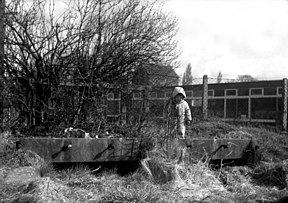Wombridge Canal
| Stourbridge Extension Canal | |
|---|---|

Remains of a bridge over the infilled canal at Wrockwardine Wood in 1963
|
|
| Specifications | |
| Status | destroyed |
| History | |
| Principal engineer | William Reynolds |
| Date completed | 1788 |
| Date closed | 1921 |
| Geography | |
| Connects to | Shrewsbury Canal, Donnington Wood Canal |
The Wombridge Canal was a tub-boat canal in Shropshire, England, built to carry coal and iron ore from mines in the area to the furnaces where the iron was extracted.
Iron ore and coal were mined at Wombridge, near to the church. In order to transport it to the furnaces at Donnington Wood, William Reynolds started to build a tub-boat canal in 1787. It was completed in 1788, at a cost of £1,640 and was 1.75 miles (2.82 km) long, connecting with both the furnaces and the Donnington Wood Canal. A curious feature of the canal was the tunnel which was constructed near to the church. There is no obvious reason for it, and it has been suggested that it was built to placate a local landowner. Another feature was an iron bridge, built in sections, which carried Teague's Bridge Lane over the canal.
In 1792, an Act of Parliament created the Shrewsbury Canal Company, with powers to build a canal from Wombridge to Shrewsbury. The company bought 1,848 yards (1.690 km) of the canal at a cost of £840. Although this price was considerably less than the cost of construction, Reynolds was both a shareholder and a director of the new company, and the Act specifically waived any tolls for his own internal traffic.
The new company constructed an inclined plane, to transport tub boats from the level of the Wombridge canal, down to that of the Shrewsbury canal. It was 243 feet (74 m) long, with a fall of 75 feet (23 m). It consisted of twin railway tracks, each with a cradle in which a single tub-boat was carried. Power was provided by an engine supplied by the Coalbrookdale Company. This was replaced in 1842 by a new engine that lasted for 79 years, until the final demise of the incline on 31 August 1921. Most of the working traffic was in the downward direction of the incline, and was counterbalanced by empty tub-boats returning up to the top level. The inclined plane was the last operational canal plane in the country.
In 1919, new furnaces were built at Wombridge and most of the rest of the canal fell into decline from then onwards. The canal was abandoned in 1921 when the inclined plane was closed. In 1968, material from the embankment and docks of the inclined plane was used to fill in the basin, destroying what remained.
...
Wikipedia
